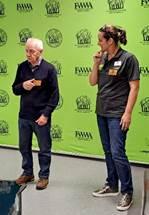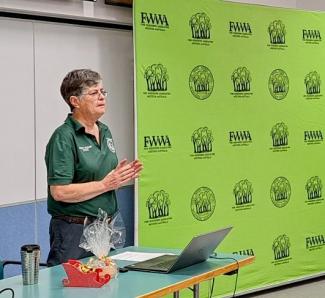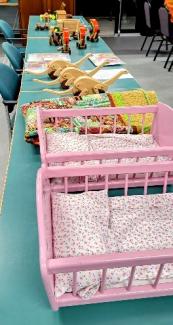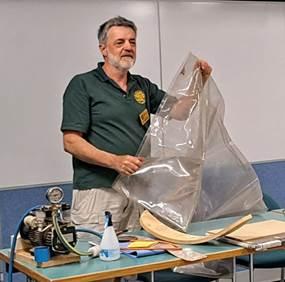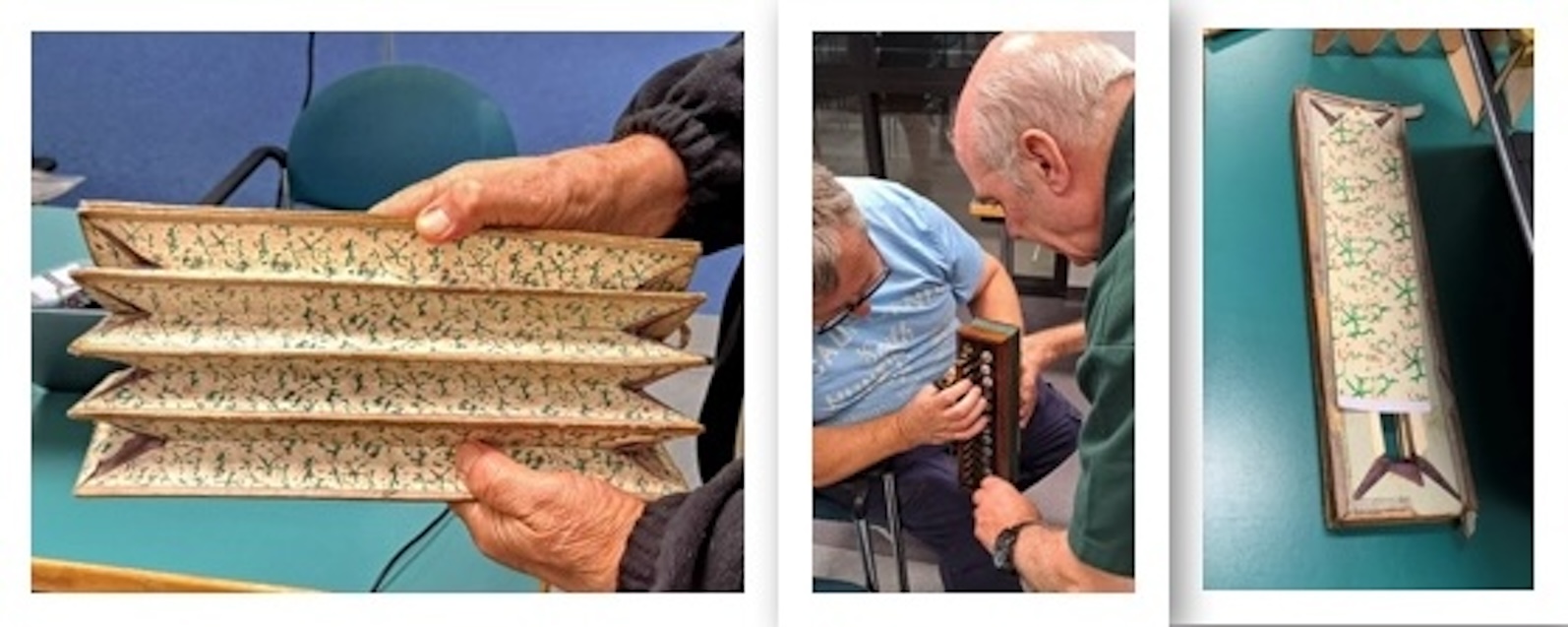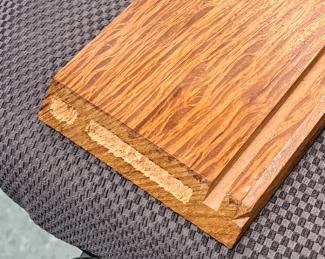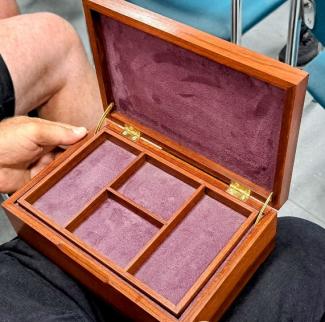Toys, Boxes and Vacuum Bags
I know I said we had a full programme to get through, but I still do not know how we managed to get finished before 10pm!
The first item on our agenda was to present Paul Birchall with his new badge on becoming a life member –
Congratulations Paul.
Carolyn said that we had got to running the AGM’s down to a fine art, but this did not really reflect the time and effort that committee members have to put in to ensure that we all enjoyed a diverse range of presenters, such as this evening.
She wanted to thank all those involved with our meetings and to introduce our committee, consisting of herself, Robert Rankin, Roger Goodridge, Harry Smith, Mark Ellis, Peter Bell, Peter Banks, Kevin Luff, Allan Waugh and our new members, Barry Viner, Garvin Crozier and Edward Petch.
She also thanked our retiring members, Steve Harris, Jeff Kenney, Shawn Ritchie and Laurie Pearson for their commitment and help in the past.
To start our meeting Martin passed around two jigs that he had been using and asked if anyone could identify what they were for?
Toys for Charities
Carolyn introduced Robyn McLean, who was a member of Melville Woodturners and their scroll saw group, who wanted to tell us about the work they were doing for our local charities.
The table at back of the room was full of a huge range of toys, dinosaurs, trucks, and lolly bowls and even a full-sized quilt that had been donated, and all this would be handed to the charities, Silverchain, MercyCare, Wanslea and Parkerville Youth Care, for distribution to all those in need in time for Christmas.
FWWA has offered to help where we can, and Robyn reminded us that all toys, should include a balance of interests, not all boys, must be robust and safe, paint should be food safe, and any string used kept to a minimum length.
She also mentioned just how competitive the Melville Turners spin-off competition had become, with everyone working hard to provide the best possible spinning top.
So, let’s get started and see what we can produce to make one more child happy at Christmas?
Any toys our members wanted to donate would need to be completed before the end of November as Melville’s handover date was in the first week of December.
All you need to know about Vacuum Bags
Ian Houghton then talked about how he uses a vacuum bag and pump to make his furniture and veneered panels.
He said he uses a variety of different sized bags and that FWWA owned a pump and bag, that was available if anyone wanted to try this system out.
If you were building one yourself, you must include a filter in the vacuum line, similar to a fuel filter with 3/8” inlet and outlets, he had fitted limit switches on his pump, so that it would control the high and low pressures, always use a bigger bag than you need, use a back board for support (he covered his with newspaper), if using MDF make sure it has been sanded, as it has a release agent on its surface, always mark both veneer and boards clearly to avoid mistakes, place your work in the bag with the best veneer face down, to help remove the air, place rope/dowl/cord inside the bag.
You should always use forms for curved work and make sure they cannot be crushed as the vacuum could reach 141/2 Lbs/ sq inch, make sure the surface you’re using is flat, as it will follow any imperfections, Ian uses a layer of commercial vinyl to protect his veneers, a water mister to dampen the veneer, and a finely notched spreader combined with Titebond 3 adhesive, as the glue takes a bit longer to go off inside the bag.
How to Restore a “Flutina”
Martin put us out of a misery and said the items sent around were Jigs for re-building the bellows of an accordion!
He often visits his favourite antique shop looking for old French clocks, which is when he found a small accordion which was dated 1835, but it’s bellows were “Stuffed”.
So naturally he set out to make some new ones! The originals are made from paper, with leather corners and cloth gasket tape. So, with the help of Len and his laser cutter, he made all the different shapes he required, and the first jig is to hold all those pieces together while the glue set, and the elastic straps hold everything in place.
The second Jig is to help assemble the separate bellows and hold it all together!
Just a few new keys, a bit of wire and of course a little mother-of-pearl and you get what Martim tells me is a fully restored “Flutina”.
These were made in France and England around the 1800’s and apparently became very popular with American soldiers during the civil war.
Amazing that the very same paper used to make the bellows is still available today!
We had a short break for tea and coffee - and do not think that I didn’t make a note of all those playing with the “Dinosaurs”!
Paul Birchall talks about Box making 101
First Paul sent around a sample of the brass screws that he used, each with a different finish applied, and asked us to guess which was best.
He said that he had been making boxes for something like 20 years and was now getting quite good at it!
Having first watched Roger Gifkin make his boxes at the wood show, his first few had dovetails or finger joints, but the joints do not need to be that strong. The simplest was a rebated joint which shows some end grain, and next strongest is the mitre joint, which is the only method he now uses.
He works on both edges of the joint before applying a thin coat of epoxy adhesive to both faces.
He makes sure the grain follows all around the box, and if he cuts the timber through the centre, he will turn the two faces inside out, so that the grain will match.
To separate the lids from the bottoms he uses his band saw, he likes to use She-oak when he can, Lee-Valley hinges are his first choice but has to buy in bulk when he can, as they tend to be expensive, he cuts the feet on his boxes using the router and always finishes the inside before the box is assembled.
His preferred finish for the inside is micro-suede attached to card using 3M craft glue spray and then fitted into the box.
When the sample of the brass screws had been returned, he confirmed that the longest lasting finish of all those applied was “Shellac”.
It was certainly a very full night, and I am confident that everyone will have gone home with at least a couple of new ideas.

